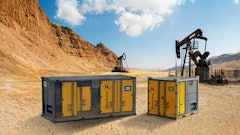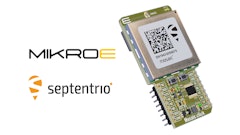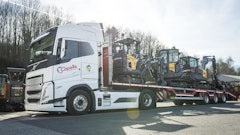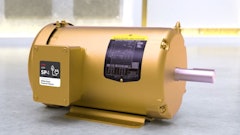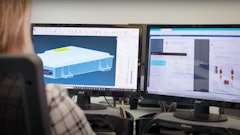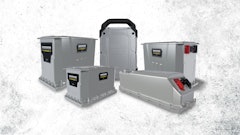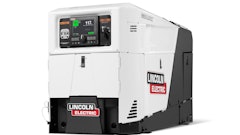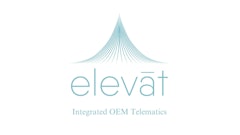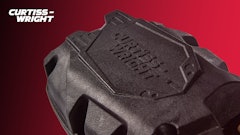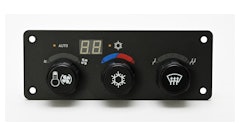
Nova Bus, the transit bus arm of the Volvo Group in North America, has been developing hybrid electric buses since 2006. The company, and the entire Volvo Group, has been focusing on these types of technologies over the past several years as a part of its Electro Mobility strategy which aims to provide more environmentally-friendly transportation solutions. Transit buses are the focus for the first stage of this strategy because they are most commonly used in densely populated areas where noise and emissions can have an effect on a large number of people.
Maxime Ouellet, Chief Program Manager at Nova Bus, says vehicle electrification was the chosen strategy “because compared to a diesel powertrain we [can] reduce a lot of emissions; not just CO2 but also NOx emissions. We also have a huge reduction in noise levels with the electric powertrain.
“That’s where the Volvo Group is going, is towards electro-mobility as the transportation of the future.”
The latest addition to Nova Bus’ Electro Mobility solutions is the LFSe 100% electric bus, which was exhibited at 2014’s APTA Annual Meeting & EXPO. LFSe utilizes electric propulsion technology and is based on the company’s heavy-duty LFS transit bus platform which has been in production and on the roads for several years.
Read more about electric bus technologies launched at APTA in the article A direction is determined.
Charging and battery technology are key
Battery selection was one of the most important components to take into consideration when developing the LFSe, as well as one of the biggest challenges. Ouellet says the company did not want to oversize the batteries to ensure the bus would still have the space required for the job in which it’s intended—transporting people. “As soon as we went for opportunity charging with the fast charging system, it relieved a bit of the stress of putting a lot of batteries on the vehicle,” he says.
Because the company chose to use what it refers to as opportunity charging, it could employ a smaller size battery than what is typically used on an electric bus. When developing the bus, Ouellet says the company knew charging was as important a factor to consider as the battery technology since the bus would be operating upwards of 20 hours per day. “Even though you have the best battery in the world, the charging is a really huge element,” he says. “A transit bus is used between 12 and 20 hours a day…so we need to have a really fast charging time.”
Nova Bus’ fast-charging system consists of a mast with an inverted pantograph that moves down onto the top of the bus to charge it. On the roof of the bus are two perpendicularly aligned rails the pantograph connects to in order to charge the bus. Very little input is required from drivers to initiate the charging process; they simply have to stop the bus under the charging station and engage the parking brake. The bus’ control system then communicates wirelessly with the charging station to start the charging process. Once completed, the system retracts from the bus roof and a notification is sent to the operator display to let the operator know he or she can continue with the route.
The charging station is located at the end of the route, and provides the bus with more than an hour’s worth of charge time. The batteries are fully recharged in 4-6 minutes, enabling buses to quickly get back to their routes. “A lot of times we focus on range, but in this case we want to focus on charging time,” says Ouellet. “We want to reduce charging time to a minimum to allow the bus to operate fully for a longer period of time.”
A total of four batteries are included on the LFSe—two on the roof and two at the rear section. The batteries are high-voltage lithium-ion batteries developed by the Volvo Group, and used in a variety of vehicles around the world including Volvo brand buses in Europe. Ouellet says it’s advantageous for Nova Bus to be using battery and power electronics technology that is shared throughout the Volvo Group because they have already been proven in this and other applications. “It’s not just good on the engineering side and the procurement side where you get economies of scale, but also good on the testing side where you have multiple types of vehicles going around the world and testing those technologies and getting maturity in them,” he says.
Download the LFSe spec sheet to see more of the technologies utilized on the vehicle.
The technology used for the fast-charging station is also implemented across the entire Volvo Group. Volvo worked with partners including Siemens and ABB to develop and integrate the system. Ouellet says the company is working towards making the technology an open solution that would enable other manufacturers to adopt the same charging technology. Additionally, Nova Bus is working with other manufacturers to develop an SAE standard for these fast-charging systems.
LFSe is currently a commercially available product, but is also continuing to go through various testing and validation efforts. In 2016, three LFSe buses will be operated in Montreal as part of Volvo’s City Mobility program.
Volvo Group’s City Mobility program is aimed at helping cities undertake innovative, integrated and sustainable pilot projects that will test the use of technologies designed by Volvo and its subsidiaries to improve energy efficiency and reduce greenhouse gas emissions. The ultimate goal is to expand the program to 10 cities, focusing mostly on electric vehicle applications. It will also apply smart technology and infrastructure solutions.
The program has been deployed in nine cities so far, including Gothenburg, Stockholm and Montreal. In Gothenburg the project is referred to as the ElectriCity project where buses are being operated entirely from renewable electricity.
Montreal is the first North American city to take part in the City Mobility program. As such, it will install two fast-charging stations along STM’s Line 36 – Monk to power three Nova Bus LFSe full-electric buses. Non-service testing of the buses will begin in 2016; it is expected to start transporting passengers in the fall, and testing will continue until 2019.





